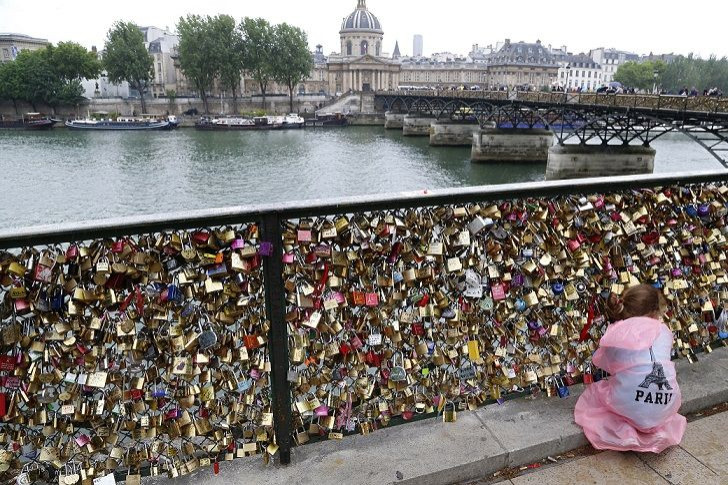Paris Love Lock Bridge History: Why Romantic Gesture Irks Preservationists

The Pont des Arts bridge in Paris, famous across the globe as a symbol of passion and fidelity, will have its roughly one million “love locks” cut off over the next few days after years of structural damage. For fans of the big romantic gesture, the decision to de-lock the bridge is as crushing as an unexpected breakup.
“It’s sad to see a symbol of everlasting love being taken down,” said Ben Schantz, a student at Stony Brook University in New York who said he had hoped to travel to Paris one day to see the locks. “In today’s world it’s not really something that’s focused on anymore.”
Other supporters of the “love locks” took to social media Monday to lament the removal of the padlocks. Daniella Qureishi, a student at Pace University in New York, tweeted, "I wish the love padlocks from #PontdesArts in France were not about to be destroyed..." She said in an email that she considered the bridge her favorite location in the world. “I feel slightly saddened. While I understand the implications, I believe that the locks should be moved to a more stable location rather than being cut off," she wrote.
Since 2008, tourists have flocked to the bridge, which connects the Palais du Louvre and the Insititut de France over the Seine, in order to leave the “love locks”--padlocks with a person’s first name written on them--in the grating of the bridge as a gesture of a couple’s love. But critics of the tradition insist the tokens of romance are wreaking havoc on a structure that is crucial to Paris’ infrastructure. Workers arrived on Monday morning to begin to cut the locks off the bridge.
“This is a great first step,” said Lisa Anselmo, a co-founder of No Love Locks, an online campaign devoted to removing the love locks throughout the city, adding that “only a ban will stop this in Paris” as the padlocks now cover “eleven bridges and landmarks including the Eiffel Tower.”
Anselmo, who is originally from New York but now lives in Paris, began the campaign to "preserve the heritage of Paris and to create awareness of the damage being done to a UNESCO World Heritage Site.” She raised over 10,000 signatures on a petition to ban the practice, which Anselmo said ultimately brought the discussion to the attention of a larger international community, as well as the first deputy mayor and former head of cultural affairs, Bruno Julliard.
A section of the fencing collapsed last year, broken by the weight of its locks. While no one was hurt, the event spurred the city to speed up the development of alternatives to replace the tradition, including a Twitter campaign started last year, #lovewithoutlocks, that encouraged visitors to take a selfie with the bridge instead of leaving a padlock.
This is a question of “responsible tourism,” said Anselmo. “it shouldn’t matter where you’re from when it comes to caring about the preservation of world heritage sites.”
The Pont des Arts bridge opened in 1804 during the reign of Napoleon as the first iron bridge in France and was rebuilt in 1984 in steel after a partial collapse. It is slated to have its metal grillwork replaced with transparent panels later this year.
The tradition of attaching padlocks onto the bridge began roughly around 2008. The custom has been traced to a 2006 novel by Frederico Moccia called “I Want You,” which features couples writing their names onto a padlock attached to Rome’s Milvian bridge before throwing the key into the river as a sign of eternal love.
While the phenomenon originated in Italy, the Pont Des Arts has quickly become associated with the tradition. About 45 tons of padlocks are now attached to the bridge, according to the BBC. In recent years, love locks have become popular tourist attractions in a number of cities, including Melbourne, New York, and Munich.
Still, many support the decision to remove the locks from the bridge, despite its romantic significance.
“I’m a fairly frequent visitor to Paris,” said Udey Johnson, a freelance writer and the author of “Paris Without The Tourists.” “My wife is French so we go there frequently and the first ten to fifteen years the [Pont des Arts] was my absolute favorite...the grill work is sublime, but recently every six months when we would return the number of locks would cover more and more. It just completely destroyed the beauty of the bridge.”
Johnson said the practice of adding padlocks to the bridge spread because of social media. “It really represents the lowest level of the Internet and acting without any cultural awareness,” he continued. "Once it became a ‘meme,’ once it became ‘viral,’ it just spread wildly and everyone began to participate.”
© Copyright IBTimes 2024. All rights reserved.






















